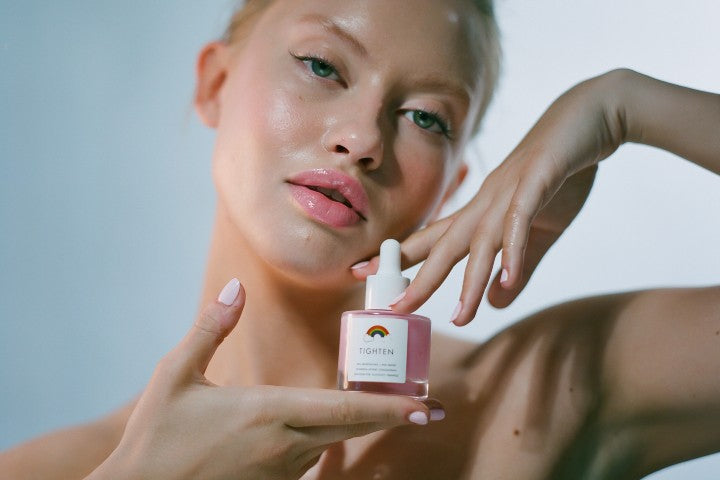Your Guide to AHAs in Skincare

There are many different acids commonly used in the skincare world. Skincare acids are typically categorized into three groups: alpha-hydroxy acids (AHAs), beta hydroxy acids (BHAs), and polyhydroxy acids (PHAs). While all of them offer benefits to the skin, AHAs stand out for what they can do for the skin.
From exfoliating away dullness to evening out skin texture, stimulating collagen production to clearing away blemishes, this active ingredient possesses many capabilities.
Below, we break down everything you need to know about AHAs for the skin including how they work, the benefits, and essential skincare products.
WHAT ARE ALPHA HYDROXY ACIDS?
Alpha-hydroxy acids are water-soluble acids most often derived from plant-based sources. They function as a chemical exfoliant, which means they use acids or enzymes to slough away dead skin cells.
Several different AHAs exist, including glycolic acid (derived from sugarcane), lactic acid (from sour milk), and citric acid (from lemons). Ultimately, they all act as chemical exfoliants on the surface of the skin. However, they all differ in size, potency, and penetration, which can affect their efficiency.
According to New York City dermatologist Marnie Nussbaum, "The smaller the molecule, the deeper the penetration, and therefore the more efficacious it is." On that note, those with increased efficiency tend to be more potent which means it can increase the likelihood of irritation.
AHAs are suitable for individuals wanting to refresh and wake up their skin. They are effective for all skin types. However, those with sensitive skin should use with care to avoid risking irritation. If you have any concerns, speak to your dermatologist.
ALPHA HYDROXY ACID SKINCARE BENEFITS
While any acid will essentially exfoliate the skin, AHAs reign supreme for their multitude of benefits.
Brightening
Use AHAs if you're looking for instant glow. Alpha hydroxy acids act like exfoliators, dissolving the glue that holds dead skin cells together, for smoother texture and increased radiance.
Exfoliation refers to a process where the build up of skin cells on the skin's surface shed off, removing dead skin and boosting new skin cell generation.
Using AHAs to exfoliate your skin breaks down skin cell accumulation to brighten skin.
Anti-Aging
Research shows that AHAs can reduce the appearance of fine lines and wrinkles.
One 2015 study found that 9 out of 10 patients who used AHAs over a three-week period witnessed significant improvements in overall skin texture.
AHAs don't just work on the epidermis. They offer effects on the deeper layer of the skin, known as the dermis. Studies indicate that all AHAs stimulate collagen production. However, glycolic acid stands out for being the most effective in fading lines and wrinkles.
AHAs also offer antioxidant properties which help fight free radical damage, maintaining the skin's integrity. Of all the AHAs, citric acid is considered the most effective for its antioxidant properties.
As effective as these skincare ingredients may be, it's important to remember that AHAs only work for surface lines and wrinkles, not deeper wrinkles. Only in-office procedures such as laser resurfacing can work for deep wrinkles.
Hydration
Glycolic acid, lactic acid, and malic acid are all humectants, which means they attract water to the skin. That is why you'll often find AHAs in cleansers, toners, moisturizers, and lotions. Dermatologists deem them highly effective for hydrating the skin and reliving dry skin.
Hyperpigmentation
Your risk for hyperpigmentation increases with age. For instance, dark spots, known as age spots, may develop as a result of too much sun exposure. In other words, it's a result of sun damage. Dark spots usually develop on areas of the body most exposed to the sun most often, such as your face, hands, and chest.
AHAs boost skin cell turnover. With long-term use of AHAs, you should see a visible improvement in skin discoloration by spurring the old, discolored cells to turn over.
Breakouts
While the BHA salicylic acid is typically recommended for treating acne-prone skin, AHAs can work just as well.
Breakouts occur when your pores are clogged with a mixture of dead skin cells, oil, and bacteria. Exfoliating your skin with AHAs can help loosen and dissolve the clog. Using AHAs in your daily skincare routine can also prevent clogging from occurring in the first place.
AHAs may also minimize the size of enlarged pores -- an issue commonly seen in oily skin prone to acne. Skin cell turnover from glycolic and lactic acids can even reduce acne scars. Best of all, AHAs can work for other acne-prone areas of your body besides your face, including your chest, back, and backside.
Dermatologists say it can take two to three months before you see acne improvements. However, with consistent use, AHAs will relieve breakouts over time. The secret really is consistency.
Improved Product Absorption
Besides their own benefits, AHAs can make other skincare products work better by enhancing their absorption into the skin.
If you have an accumulation of dead skin cells, your daily vitamin C cream or retinol serum sits on top without penetrating skin cells beneath. AHAs like mandelic acid and glycolic acid break through this layer, enabling your products to work their best.
RECOMMENDED SKINCARE PRODUCTS WITH AHAS
Rainbow's Glow Bundle
This bundle features our Glow Mask and Serum Booster, formulated with bakuchiol and glycolic acid to improve skin tone, refresh skin, and give your face its bounce back. It also protects skin from environmental aggressors like pollution and UV rays.
Rainbow's Tighten Bundle
This anti-aging mask and serum duo combines antioxidant-packed red microalgae with a blend of alpha hydroxy acids to minimize wrinkles, boost collagen production, and buff away dead skin cells for a youthful, dewy glow.
Always follow up with a sunscreen SPF 30 after applying the serum to protect your skin from skin-harming UV rays, and keep it looking its healthiest. If you're looking for some extra hydration, apply a hyaluronic acid-formulated face cream after the serum and before the sunscreen.
AHAs are certainly worth incorporating into your skincare regimen. They treat a wide variety of skin concerns, and come with very few side effects.
